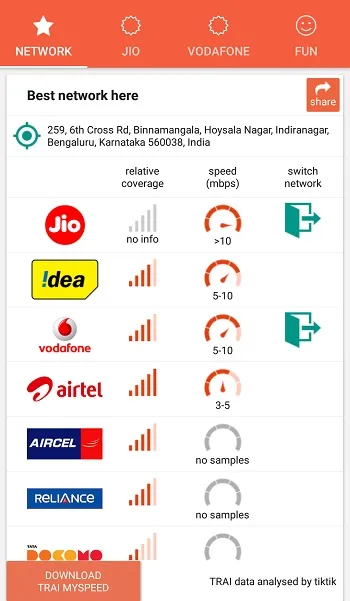Facing call drops or interruptions? Tiktik helps users pick most suited telecom network in their area
Call drops and network interruptions can cause distress and confusion. An IIIT Hyderabad-incubated startup founded by telecom and technology veterans wants to help consumers pick the best mobile networks in their area.
Hello. You can’t hear me? Ok, let me call you back from a spot where the signal strength is better.
Most of us have probably been part of such conversations when our mobile networks see such poor signal strength mid-way through a call that it has to be restarted. This can be an annoying experience for both professional and personal conversations.
Based on our personal experience we may have some estimates about which service provider has the most stable networks at our office or homes. But we probably do not have such estimates for new or unknown locations that we don’t frequent as much.
Tiktik aims to solve this pain point and help consumers assess the strength of their mobile provider’s networks before their phone calls, and hence ensure that both parties involved can take necessary actions.
Tiktik was founded by two friends, Y Ravi and Anil Kumar, who have prior experience working in the telecom space and a top chip company, respectively. Here is their story in this week's App Friday section-

Story so far
Ravi, a graduate from IIT Delhi and IIM Bangalore, quit as a marketing head at Airtel to co-found tiktik, with Anil, a graduate from Andhra University who has considerable experience at Broadcom, a top chip company. Talking to YourStory about what motivated him to launch the new venture, Ravi spoke about the market size. He noted,
In India, more people use telecom services than toothpaste….
According to a recent TRAI report there an estimated 1,186 million wireless subscribers in India, and given the rapid adoption of smartphones and slashed prices for mobile data, it isn’t surprising that most of us prefer to check our smartphones first thing in the morning rather than go brush our teeth.
Based on their understanding of the telecom sector, Ravi and Anil observed that almost every category under e-commerce has a comparison platform but there were no prominent players that let consumers benchmark the best network for their locality. So they decided to work on this problem from the ground-up and improve the experience for both telecom players and end consumers.
After working on the platform for a few months, tiktik was launched recently in its current avatar, which lets users benchmark different mobile networks based on their signal strength and mobile internet speeds at a particular location. The app also provides recharge offers based on the consumer’s SIM card usage patterns. The startup is currently incubated at IIIT Hyderabad and consists of a three-member team. Deepu, a back-end developer, is the third member of their team.
Talking about how tiktik works, Anil said, “The app looks simple to use, but believe me, the tech behind it isn’t so. Just like weather API, we have built a network API that we can integrate with other apps.”
How tiktik works
Instead of relying on third-party sources, which may or may not be accurate, tiktik analyses publicly available operator information on Telecom Regulatory Authority of India (TRAI) to present a five-star rating for all networks in one’s locality.
“For a country of our size, there cannot be just one best network, there can be a best network for your mohalla and this changes by the mile,” explained Ravi.
Apart from English, tiktik also works in all Indian languages. The app though works only for prepaid SIM cards at this stage. Ravi estimates that about 95 percent of Indian consumers are currently on prepaid networks and are hence their main target market.
Currently available only for Android users, the app occupies 3MB of storage. Ravi noted that tiktik sources the best “made-for-me” offers from one’s operator through their proprietary technology. He said,
Unlike payment apps, the offers are given by the operator directly, so you can be assured of the correct benefit. These special offers provide minimum 30 percent more value compared to the market recharges. Offers are also custom made for your usage.

I tried out tiktik on my phone, to better understand the product. Setting my location at YourStory’s office, I found that Jio provided the fastest mobile internet experience in the area, with estimated average speeds greater than 10 MBPS. Airtel, on the other hand, seems to have the strongest signal in the area.
Relative coverage and internet speed info are currently unavailable for some players with ‘no info’ or ‘no samples’ listed next to them. Ravi clarified that since Jio is a recent entrant in the telecom space, they haven’t been able to source the coverage data yet through TRAI or other sources
In case of internet speed samples he noted that these speeds are crowdsourced from different users in the area to ensure accuracy. So ‘no samples’ means that not enough users of those networks have frequented that locality.
Revenue model and future plans
Tiktik is currently free to download and use for end consumers. Ravi and Anil aim to monetise the platform on the B2B front by mainly focussing on lead generation for telecom players and ancillary service players.
Since India is a Android-focussed market and tiktik is currently bootstrapped, the team aims to focus only on Android for now and have no plans to launch an iOS version in the near future. While players like freecharge, Paytm and others let consumers search for recharge offers, Ravi noted that since tiktik sources offers directly from operators and it doesn’t generate direct revenue through it, they don’t really look at them as competition.
Talking about other use cases, Ravi noted that if a user is unhappy with the mobile network that they are currently using in their locality, tiktik can help customers make better decisions and port to the SIM card that provides the best experience in their area. They can also provide telecom operators leads to customers who are more likely to switch to their network.
Ravi noted that in the near future one will be able to purchase or port to a new SIM card through tiktik. He clarified, though, that the telecom player will take care of the last-mile experience and tiktik will function as a lead generation and technology partner.
Another interesting avenue that tiktik could explore is suggesting the best telecom operator to users based on their movement patterns. A frequent business traveller to multiple cities may want to know the best operator based on the routes and places that he or she commonly visits. Aggregating and processing the data across these routes and locations and then providing a recommendation could be a useful feature for future iterations of the app.
You can download the app here- TikTik







